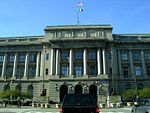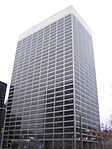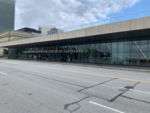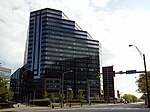East 9th–North Coast station

East 9th–North Coast (signed as North Coast) is a station on the RTA Waterfront Line in Cleveland, Ohio. The station is located west of East 9th Street, south of the Cleveland Memorial Shoreway, and north of the CSX railroad tracks. Entrance to the station is from the west side of East 9th Street. It serves the North Coast Harbor attractions, as well as the northern portion of downtown. The station has fare collection booths for the collection of fares from passengers entering toward Tower City Center and leaving toward South Harbor. When the station is unmanned, fares are collected on the trains. The station was designed by the firm of Robert P. Madison International, founded by the prominent African American architect. It was designed to harmonize with the style of the nearby Rock and Roll Hall of Fame, for which the Madison firm was also associate architects.
Excerpt from the Wikipedia article East 9th–North Coast station (License: CC BY-SA 3.0, Authors, Images).East 9th–North Coast station
South Marginal Road, Cleveland
Geographical coordinates (GPS) Address External links Nearby Places Show on map
Geographical coordinates (GPS)
| Latitude | Longitude |
|---|---|
| N 41.506388888889 ° | E -81.693888888889 ° |
Address
East 9th–North Coast
South Marginal Road
44103 Cleveland
Ohio, United States
Open on Google Maps











